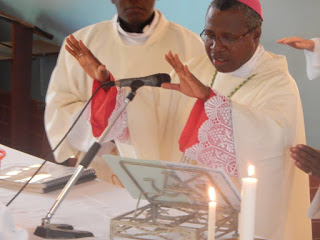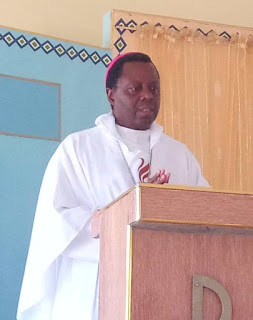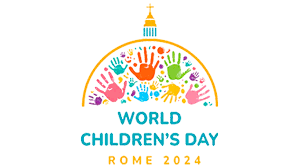ZAMBIA: Chipata- a privileged Diocese with an Auxiliary Bishop

Rt. Rev. Benjamin Phiri, Auxiliary Bishop Chipata
Part Three of the serialization of Chipata Diocese
By Pamela Adinda, AMECEA Online News
Photos Courtesy of Fr. Jacob Zullu
Chipata being the only Diocese in Zambia with two Bishops, Christians have the advantage of seeing the Bishop more often and get more pastoral services from a bishop. Instead of being visited once, in two or three years, parishes would be visited at least once every year and for many, two or three times in a year.
Other than the usual pastoral visits, occasions such as administration of the Sacrament of Confirmation or major functions of the lay movements are always be graced by the Bishop.

Bishop of Chipata
Chipata Diocese is a rural Diocese in the Eastern part of Zambia. It sits in quite an extensive land which covers a total surface area of 69,000 square Kilometres. However, the population is not big and, according to Rt. Rev. Benjamin Phiri the Auxiliary Bishop of Chipata, the population is hardly two million people in an area which is almost the size of the neighbouring country Malawi.
Within Chipata Diocese is one of the Zambia’s main game parks, the Luangwa South National Park which makes part of this territory. The people in mainly depend on subsistence farming and being an agricultural-based economy, it means that the local Church also depends on farming.
“If the people have a good harvest, it means that the local Church will have good financial sustenance, and if the crops fail or something goes wrong with the rainfall or marketing of farm produce then the local Church is directly affected,” Bishop Phiri said, adding that even though it is somewhat disadvantageous in terms of sustenance of the diocese, there is potential to develop and do well because agriculture has a future provided that the market forces are favourable.
“We have a Catholic population of roughly 400,000 on paper. I am saying on paper because sometimes those who are really active and supporting the Church are much less, and I suppose it is like that in many dioceses.”
Secret to Growth of Christianity in the Diocese
Small Christian Communities, outstations and Catechists attributed to the tremendous growth of Christianity, particularly Catholicism in Chipata. According to Bishop Benjamin, Chipata diocese is characterised by economic challenges. However, this has not impacted negatively on the growth of the Catholic Church – thanks to the Small Christian Communities, the sub-parish structure and a strong Catechists, the Church is growing rapidly.
The Diocese follows the Small Christian Community structure and as well as the outstation structure. Each outstation has a full-time catechist, not a volunteer.
“Since 1954, in Chipata we have had a training centre where we train these full-time catechists. They are invited for two-year courses as husband and wife, together with their families. In some instances, both husband and wife are catechists; sometimes though rarely, the wife is the catechist; but in most cases, it is the men who are catechist,” Bishop Benjamin explained, adding that the catechist manages the activities in the Small Christian Communities as well as in the outstations, “they are more or less the eyes and the ears and the hands of the parish priests.”
Owing to the expansiveness of the Diocese, some parishes have a surface area of more than 2,000 square Kilometres and therefore one would cover a distance of 65 or 80 kilometres and still be within one parish. This, according to Bishop Benjamin, means that the priests have a challenge in terms of having to cover quite a considerably big distance, and this is where the catechists come in handy.
The growth of Church in Chipata is witnessed in the sense that parishes are ever full and seem not to accommodate the whole congregation. “If you build a church today, even before you start using it, you will realize that it is already small, so you have to think about building another one. We have very few parishes where I can go and say the Mass inside the church building because usually many people come for the Eucharistic celebration when a Bishop is around. Therefore, Mass has to be celebrated outside the church building.”
Chipata has about 70 diocesan priests – 10-15 missionaries, mostly Comboni Missionaries, the Marian Hill Missionaries, the White Fathers who are currently running one parish each, and the Montfort Missionaries who are running a Marian Spiritual centre at Mphangwe in the Diocese. Therefore, the Small Christian Community system and the structure of outstations helps in managing the pastoral activities of the diocese which has about 34 parishes.
Promoting the Spirit of Self Reliance in the Diocese
The Diocese is also promoting the spirit of self-reliance among the Christians, challenging them to develop the parishes. Bishop Benjamin attests that amidst economic difficulties, Christians from Chipata Diocese are doing fairly well because most of the parishes are able to feed their priests and to take care of their pastoral expenses, especially the priests’ transport.
“When I go visiting any parish, the parish always contributes towards my fuel expense and for this I sincerely thank our parishioners because it is a demonstration that we are on the right track. I believe that if the people are empowered economically, if they can be emancipated from dependence, the diocese will pick up; but when people are economically struggling, the diocese also struggles,” explained Bishop Phiri.
∽End∽


